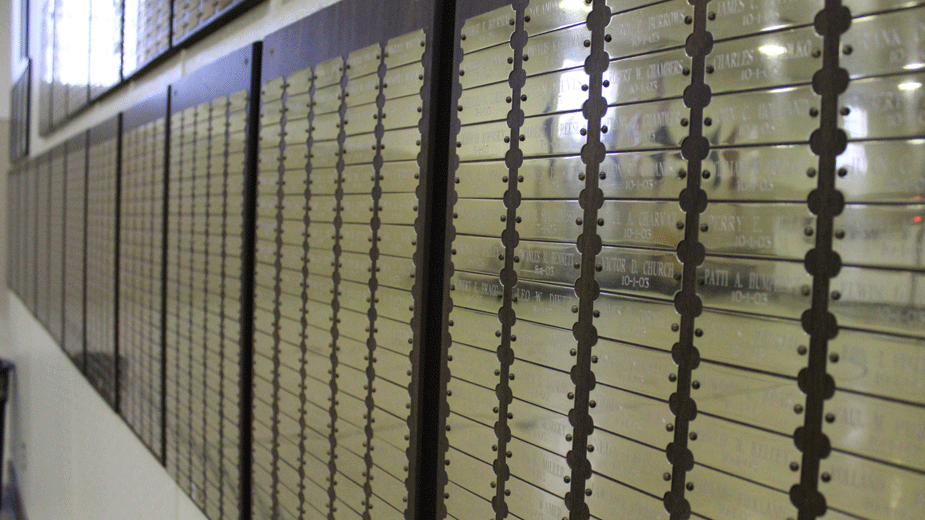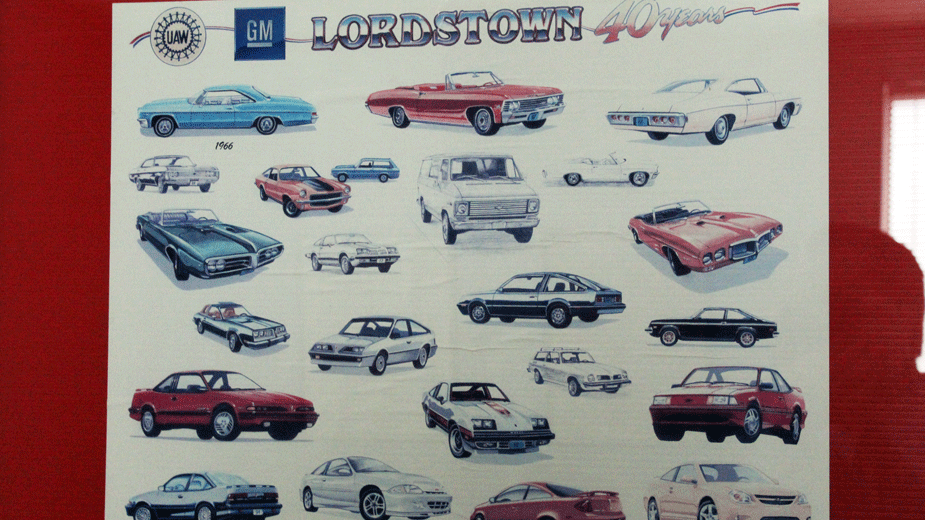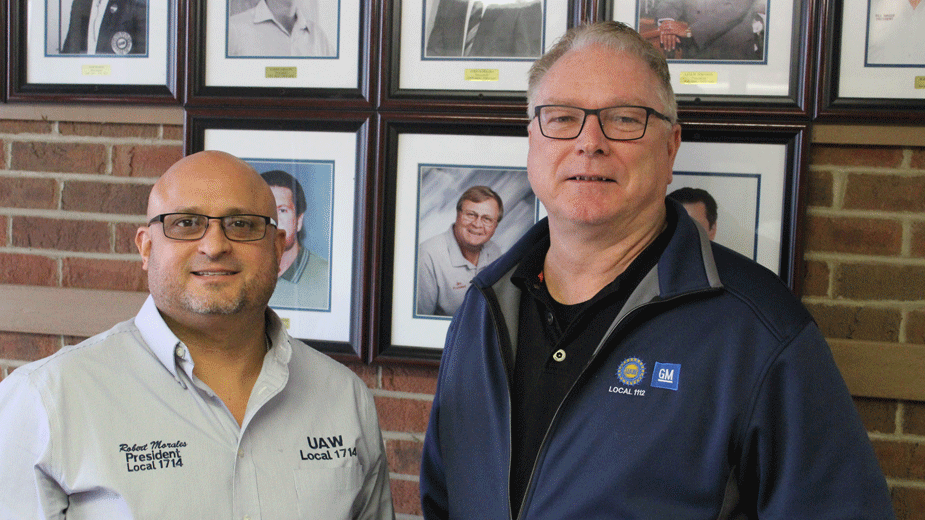As UAW Locals Merge, a New Era Begins
YOUNGSTOWN, Ohio – As you drive past the General Motors Lordstown Assembly plant, you see vast slabs of concrete, a parking lot that once served its 15,000-plus workers who filed inside to build many different Chevrolet cars and vans.
Today, the parking lot is scattered with the cars of the 3,000 employees, a fifth of the peak. Those who travel the Ohio Turnpike can easily see the solar panel array.
Things have changed, for GM Lordstown, for the Mahoning Valley and for the auto industry. Small cars aren’t selling as they did in the midst of the Great Recession when the price of gasoline crept up toward $4 per gallon.
It was with those changes in mind that Glenn Johnson, president of Local 1112 of the United Auto Workers, and Robert Morales, president of Local 1714, reached the decision to merge the two locals.
The announcement came Sept. 22, days before the two-week plant shutdown that resulted from declining sales of small cars across the country. From their peak in 2014, when 273,060 Cruzes were sold, fewer and fewer have been sold each year since, falling to 184,751 in 2017. This year didn’t start any better as year-over-year Cruze sales fell 45% to 10,858 in January.
“We couldn’t jeopardize 3,500 members’ lives and their families and their communities,” Morales says. “The decision was made to better everybody and we stand behind that decision as leaders.”
Johnson and Morales say there were rumblings about the possibility of merging the locals, although the topic wasn’t broached until they met in Detroit with General Motors the international UAW leadership that included the regional UAW office. The meeting was held July 25. More discussions followed before they met with their rank-and-file.
“GM said, ‘Small cars aren’t selling and the capacity we have to build small cars is more than we need. We’re going to do what we have to do to right our ship,’ ” says Rich Rankin, president of the UAW 2-B Region, which covers Ohio and Indiana. “I have to give GM credit on this because they stepped up and said, ‘We don’t need labor to do everything, but we need you to do your part.’ They tasked the Lordstown team with a percentage of the cost reduction. That gave the locals options.”
Those options, say Morales and Johnson, were straightforward: merge the locals or keep operating as normal and hope for the best.
“There were two choices. We could either put ourselves in a better position to make sure our members have a place to work, raise their families and invest in our community,” Johnson says.
“Or we could do nothing and let the chips fall where they may. For us, doing nothing was not an option.”
Initially, there was some outcry from members, a reaction that Johnson says he expected.
“Did we know that when we came back home that we’d face criticism and anger? Sure,” he says. “But sometimes as a leader you have to do things that are right for the masses and understand that with explanation, education and time, all those things will go away.”
Local 1714 was formed in 1970 when workers in the fabrication plant voted to create their own unit, frequently citing the differences between how they did their jobs and those in assembly as well as the number of workers 1112 already represented. At the time, Local 1112 represented 15,000 workers.
 Plaques at the UAW Local 1714 union hall list the names of retirees.
Plaques at the UAW Local 1714 union hall list the names of retirees.
For members of Local 1714, the goal is to have nothing change except the number of their local. Seniority and benefits will be kept, as will wages. The changes will follow guidelines established in paragraph 96 of the national agreement between the UAW and General Motors, Rankin notes.
“The paragraph 96 language allows GM to transfer the work and that’s what they did,” he continues. “Back in 2011 or 2012, the body shop [at GM Lordstown] was transferred from the assembly plant to the fabricating plant. It was unpopular but everybody still had the job. You just switched the number.”
But even with the rules in place, there was still legwork the union had to take care of. Integrating the seniority of all members was time-consuming, Johnson and Morales say, and a new contract that incorporated all facets of the work done at the Lordstown Assembly had to be drawn up between management and the locals.
There are many similarities in the 1714 and 1112 contracts, but because 1714’s members do different work than those in 1112, the new duties – such as those in the metal-pressing plant – had to be added.
“The Local 1112 agreement doesn’t have anything in it that deals with the pressing room,” Morales says. “It wasn’t cherry-picked, where we took what’s good from this and what’s good from that and put it over there. It was the language that we had on our side of the business that was put with the language they have on their side.”
The merger process also has to deal with matters such as the 1714 building on Salt Springs Road and its office staff, which have their own contracts that need to be honored. Just as the UAW locals negotiated with GM, the secretaries negotiated with the locals.
“They’re employees and we’re responsible for medical and life insurance and things like that. We had to sit down with their negotiator and come up with a plan to make sure they’re taken care of,” Morales says.
“As far as the building goes, we’ve had talks with our regional and international [offices] about how we can sustain the building. We’ve talked about having the retiree chapter operate out of the building.”
Navigating the process has been lengthy. Johnson likens it to peeling the layers of an onion.
“You get up, peel back a layer, see what stinks and you fix it. We’re getting to the bottom of the onion and have gotten most things fixed,” he says.
There’s also the fact that the merging two locals at an auto plant is rare. The only recent examples Johnson and Morales had to look to were the merger of locals at Flint Engine Operations, where locals merged in 2016, and the shift at the Warren Transmission and Orion Assembly. All three sites are in Michigan.
Following the unification of 1112 and 1714, every GM plant in the United States will be represented by one local.
While a wholesale blueprint to follow wasn’t available, Rankin says, a piecemeal guide was available by looking at the mergers that have happened at other unions, both within and outside the UAW.
“Even though there are few examples of this particular instance, we have many examples of local union mergers and, unfortunately, locals that have closed,” he says. “As an example, Local 2901 in Warren, Ohio, merged with 1112 back in 2013. The process was very similar. … This is a combination of a bunch of things even though it’s only happened twice.”
The UAW 2-B Region office provided attorneys as necessary to review the new paperwork, both that between the union and management and the locals and their clerical staff, Rankin continues.
“We had a rep go in and help with that, providing an attorney who’d done it in other areas of the UAW,” he says. “The membership is the highest authority in the UAW. We, as a region, offer any assistance that local leadership needs from us within our jurisdiction.”
Once all of that is finished, the UAW international must clear the final product before it takes effect, Morales says. Nearly everything in this process has been checked, double-checked and checked again.
“Any decision that’s been made has had direction from a higher authority. We worked with an attorney from Indiana to help close out the settlement with the secretaries. We had to get approval from the International and then we had to send it to another attorney in Ohio to review,” the 1714 president says.
While the merger’s effective date was Feb. 5, there will still be work to do in the months ahead, Johnson says.
“We’ll be officially combined on paper, but because of the logistics of the UAW and how business works, it’ll take a little longer to do a closeout audit. In the meantime, Robert is running the business [at UAW Local 1714],” he says.
When all is said and done, UAW Local 1112 will have roughly 3,000 members at GM Lordstown Assembly, plus another 600 or so in places such as Magna, Jamestown Industries and Kmart distribution center in Warren.
 A picture in Robert Morales’ office shows every model produced at Lordstown through its first 40 years.
A picture in Robert Morales’ office shows every model produced at Lordstown through its first 40 years.
It’s those workers that the merger benefits, say Johnson and Morales, as they have since they broke the news to membership last year. After all, Morales and the rest of the 1714 leadership will be out of jobs when the merger is completed.
The unification puts the whole GM Lordstown Assembly in a better position for future work, the duo says.
While General Motors has committed to build sedans at the plant through the early 2020s – models are usually produced on cycles lasting four to six years and the Cruze’s last update was in 2016, meaning around 2021 “based on the usual math,” Johnson says – the next contract negotiations are in 2019, as is GM’s allocation process.
The announcement of what the Lordstown Assembly’s next model could be won’t come until GM has all the pieces in place, the 1112 president says.
“They don’t release timelines for anything for competitive reasons. This is a highly competitive market and the company won’t tip their hand until they’re ready,” Johnson says.
When the announcement does come, he and Morales hope the work done since the meeting in Detroit last summer, along with upgrading the plant to GM’s Built-In Quality Level III and the density of GM vehicles in this region, will pay dividends.
“We’ve consistently stepped up to the plate to get product, to make product, to improve our processes,” Johnson says.
“When we get to those benchmarks, we can wave the flag and General Motors won’t be able to deny the fact that we’ve done everything GM has asked of us. Now it’s time to give us something to give our members the opportunity to come to work every day.”
Pictured: UAW Local 1714 President Robert Morales and Local 1112 President Glenn Johnson.
Copyright 2024 The Business Journal, Youngstown, Ohio.


